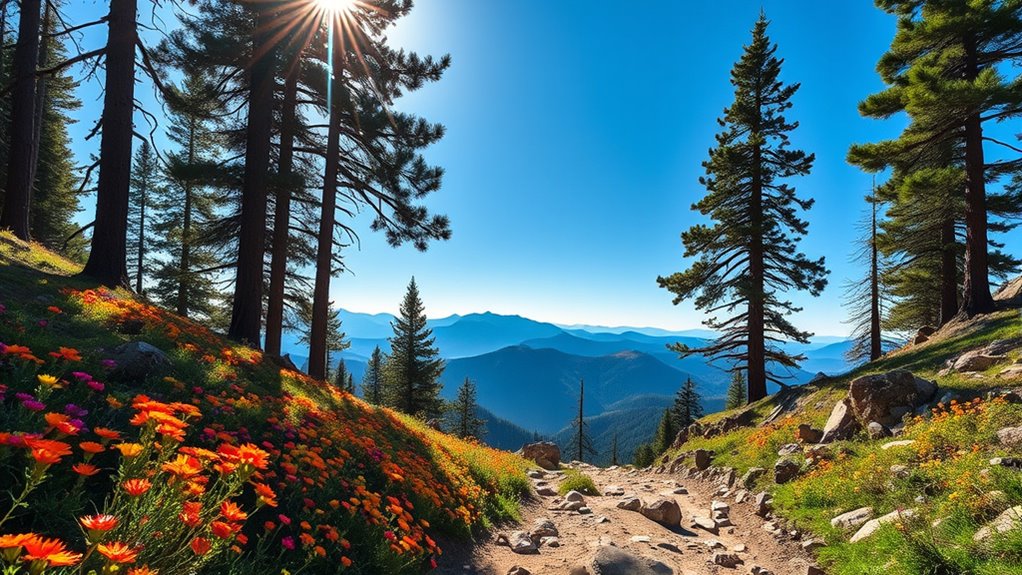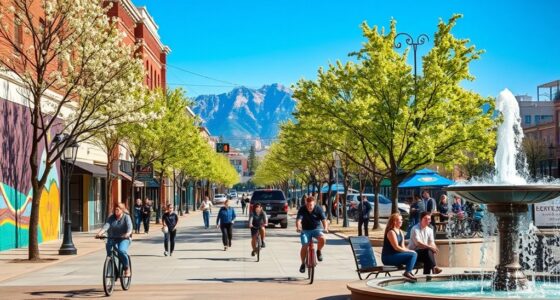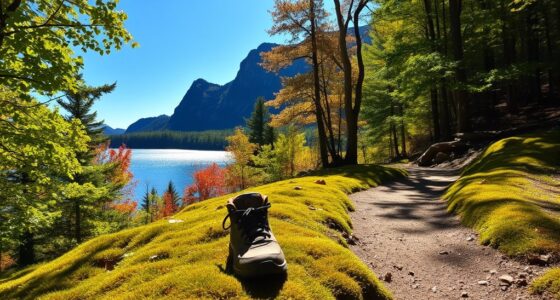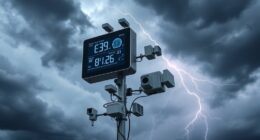To travel safely in California’s Sierra Nevada during wildfire season, stay alert with fire alert apps and local updates, plan routes away from active fire zones, and choose campsites with fire-resistant features. Pack fireproof clothing, safety gear, and emergency supplies. Follow fire restrictions, respect designated zones, and know evacuation procedures. Being proactive and informed helps protect you and your loved ones. Continue exploring these essential steps to ensure your adventure remains safe and enjoyable.
Key Takeaways
- Monitor real-time wildfire alerts and signs like smoke, burn scars, and dry vegetation before and during your trip.
- Plan routes using fire maps, avoiding active fire zones and knowing evacuation routes for emergencies.
- Choose campsites and lodging with fire-resistant features, and adhere to current fire restrictions and bans.
- Pack safety essentials such as fire-resistant clothing, first aid kit, flashlight, and emergency communication devices.
- Stay informed, remain calm, and follow evacuation procedures promptly if wildfire hazards arise.
Monitoring Wildfire Alerts and Updates
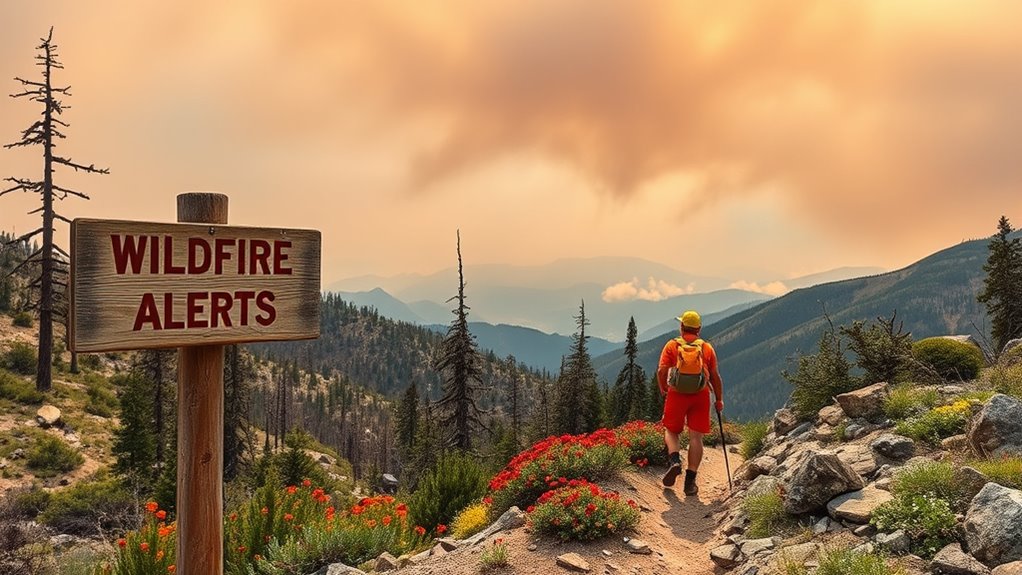
To stay safe while exploring California’s Sierra Nevada, it’s essential to monitor wildfire alerts and updates regularly. Fire alert apps are your best tools for real-time information, sending notifications about nearby fires and changing conditions. Download trusted apps like Cal Fire or local emergency services to stay informed. Additionally, keep an eye on wildfire news through official websites and news outlets to understand current wildfire activity and forecasts. Regularly checking these sources helps you plan your activities, avoid dangerous areas, and respond quickly if fire conditions change. Staying proactive guarantees your safety and allows you to enjoy your trip without unnecessary risks. Remember, timely information is your best defense against wildfire threats during your adventure in the Sierra Nevada. Incorporating fire alert systems into your preparedness plan can significantly enhance your safety measures.
Planning Your Route to Avoid Fire Zones
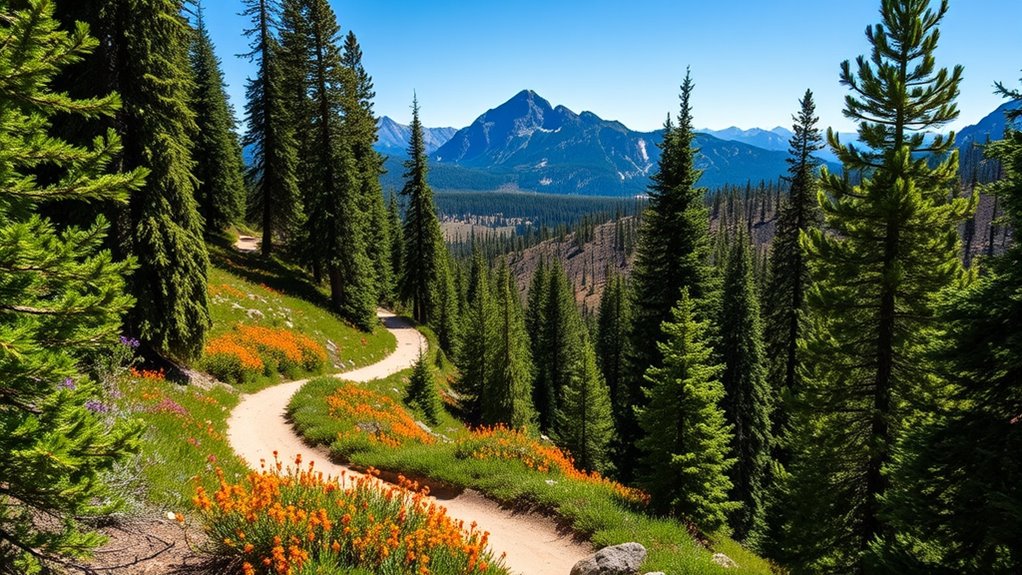
Planning your route carefully is essential to avoiding fire zones and ensuring a safe trip through California’s Sierra Nevada. Start by researching current fire maps and alerts to identify areas affected by wildfires. Use route planning tools to plot the most direct and safe pathways, prioritizing roads that are less likely to be impacted. Consider alternative pathways in case your primary route becomes compromised or blocked. Be flexible and ready to adjust your plans based on real-time updates. Avoid traveling through known fire-affected regions or areas with active fire activity. By proactively designing your route, you reduce the risk of getting caught in a fire zone and enhance your safety during your journey through this rugged landscape.
Choosing Safe Campsites and Lodging Options
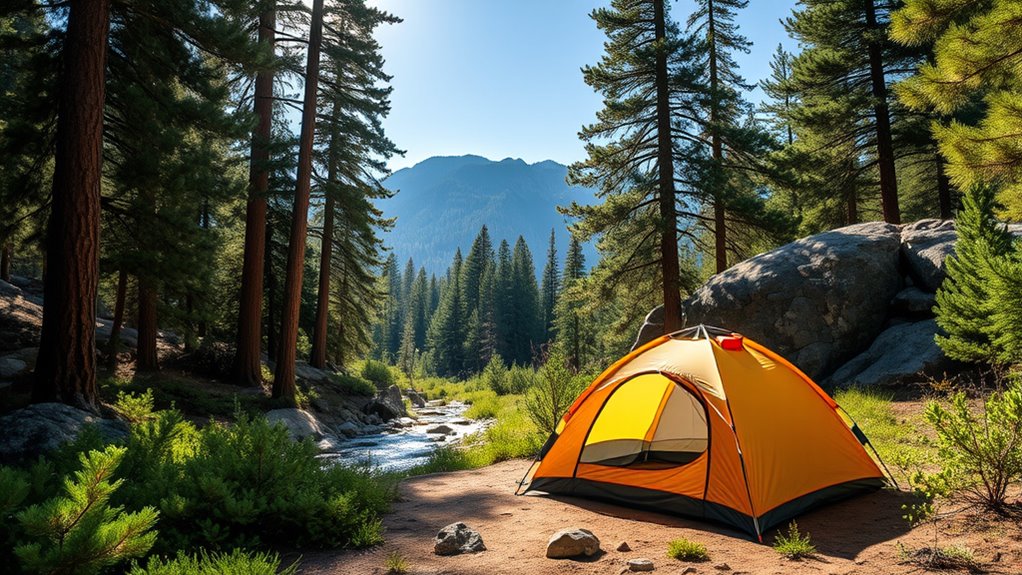
When choosing campsites and lodging options in the Sierra Nevada, it’s crucial to prioritize safety by selecting locations away from fire-prone areas. Focus on campground selection that minimizes your risk, such as sites with clear access routes and no nearby dead trees or dense vegetation. Look for lodging options that emphasize lodging safety, including properties with fire-resistant landscaping and well-maintained firebreaks. Avoid areas near heavy brush or downed trees, especially during dry seasons. Research your options beforehand, reading reviews or contacting management to confirm wildfire preparedness. Staying in designated campgrounds or lodges with fire safety measures ensures quicker emergency access if needed. Making thoughtful choices about where you stay helps keep you safe during wildfire season in the Sierra Nevada. Additionally, recognizing and understanding signs of wildfire danger can help you respond promptly and stay safe during your trip.
Packing Essentials for Wildfire Season
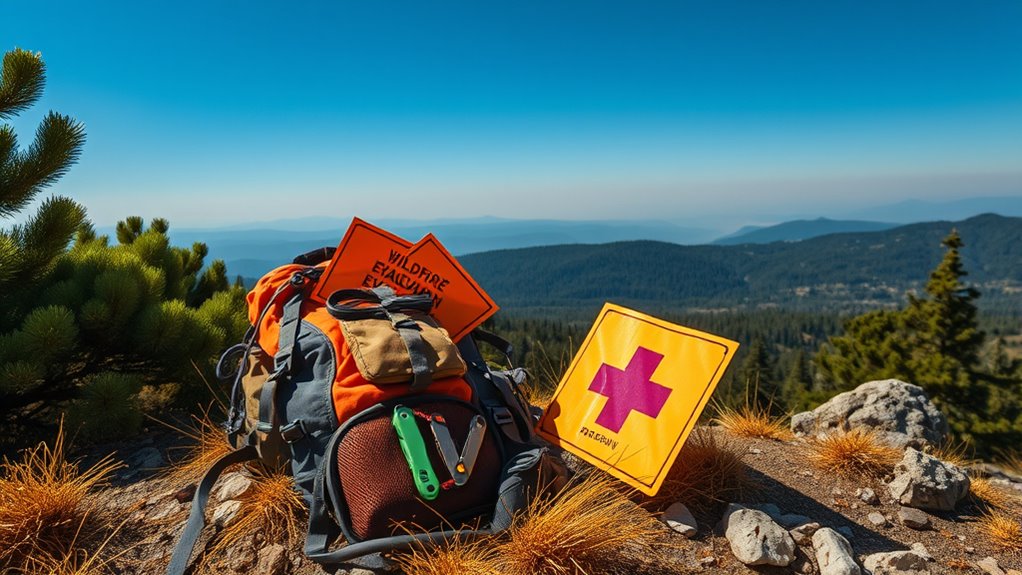
Preparing your packing list for wildfire season in the Sierra Nevada means focusing on essentials that keep you safe and prepared for emergencies. Pack fire resistant clothing to protect yourself if a fire suddenly risks proximity. Don’t forget to bring necessary wildfire insurance documents, ensuring coverage in case evacuation becomes unavoidable. Include a well-stocked first aid kit, a flashlight, and extra batteries for emergencies. Consider packing a portable phone charger to stay connected, and carry a multi-tool for quick fixes or safety needs. These essentials help you stay prepared and responsive. Remember, being proactive with the right gear can make all the difference during wildfire season, giving you peace of mind and increased safety in unpredictable conditions. Additionally, understanding sound design techniques can help you effectively communicate safety information through audio alerts or warnings in emergency situations.
Staying Informed During Your Trip
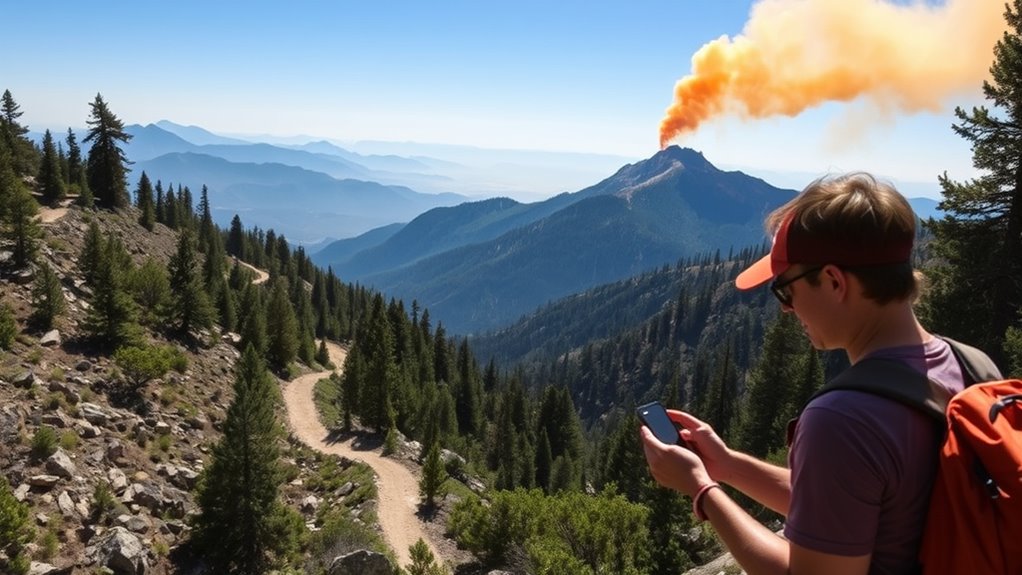
Staying informed during your trip is essential for safety and enjoyment in the Sierra Nevada. Regularly check local fire alerts and weather updates to stay aware of wildfire evacuation notices and fire prevention measures. Sign up for emergency alerts on your phone, and listen to park rangers or authorities for current conditions. Use the table below to understand key safety tips:
| Fire Prevention Measures | Wildfire Evacuation | Important Contacts |
|---|---|---|
| Keep fire extinguishers handy | Know evacuation routes | Local fire department |
| Avoid open flames in dry areas | Follow official evacuation orders | Park ranger stations |
| Dispose of cigarettes properly | Have an emergency kit ready | Emergency services |
| Maintain a defensible space | Monitor wildfire updates | Visitor information centers |
| Report suspicious activity | Stay calm during evacuations | Local authorities |
Remaining vigilant helps protect you and the wilderness. Additionally, being aware of signs of smoke or fire can help you respond quickly to changing conditions and stay safe.
Recognizing Signs of Wildfire Risks
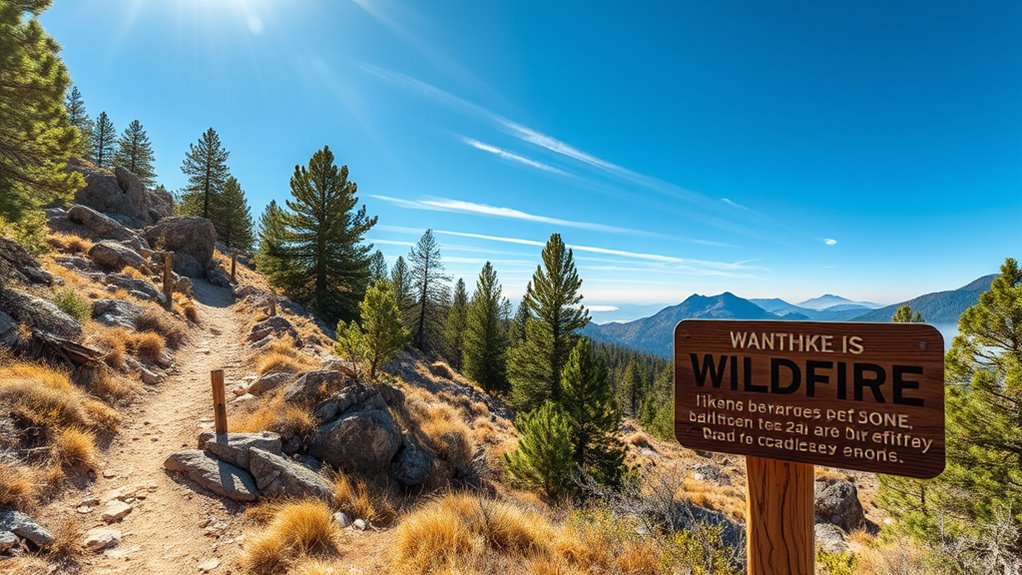
You should stay alert for signs of wildfire risks, such as fresh burn scars or areas that look recently affected by fire. Keep an eye out for smoke or strong odors that might indicate nearby fires. Also, watch for dead or damaged vegetation and scattered debris, which can signal increased fire danger. Additionally, be aware that fire-resistant plants can help reduce the spread of wildfires in the area.
Burn Scar Indicators
Have you ever noticed dark, stark patches on the landscape after a wildfire? These are classic burn scar indicators, showing where fire cleared vegetation. Pay attention to the color and texture: fresh scars often look charred and bare, while older scars may show signs of vegetation regrowth. Recognizing these signs helps you assess wildfire risks and stay safe. Look for:
- Areas with minimal or no vegetation regrowth
- Dark, blackened soil patches
- Sparse, dead trees or stumps
- Lack of green cover where vegetation once thrived
- Signs of erosion or exposed roots
Understanding burn scar indicators allows you to identify zones still prone to fire or unstable terrain. Always respect these zones, as they can signal ongoing risks and unstable ground even long after the wildfire has passed. Top 10 anime films and the storytelling techniques used in animation can also inspire awareness of natural environments and their preservation.
Smoke and Odor Signs
When wildfire risks increase, smoke and strong odors often serve as early warning signs. You should pay close attention to smoke and odor signs, as they can indicate nearby fires. Wildfire smoke patterns tend to drift with the wind, so if you notice a haze or a smoky smell, it might be time to reassess your plans. Persistent odors of burning vegetation or a sudden change in smoke direction can signal an active fire close by. Keep track of local air quality reports and stay alert to any updates from authorities. Recognizing these signs early helps you make safer decisions, such as evacuating or changing your route. Trust your senses and stay vigilant—smoke and odor signs are vital indicators of wildfire risks. Incorporating immersive soundscapes into your awareness can also help you detect subtle changes in your environment related to wildfire activity.
Vegetation and Debris
Wildfire risks are often visible through the state of the surrounding vegetation and debris. Look for dry vegetation that’s easily ignitable and fallen debris that can fuel flames. These signs indicate a higher wildfire hazard. To stay safe, pay attention to:
- Overgrown brush near trails or structures
- Accumulated fallen leaves and branches
- Dead or dying trees with brittle branches
- Areas with excessive dry vegetation due to drought
- Piles of debris that could ignite easily
Recognizing these signs helps you avoid risky areas and reduces the chance of accidental ignition. Maintaining a safe distance from dry vegetation and debris is essential, especially during dry seasons when wildfires spread rapidly. Being aware of vegetation and debris conditions can significantly improve your wildfire safety, and staying alert to these indicators keeps your travel safer and more wildfire-aware.
Responding Appropriately if Wildfires Break Out
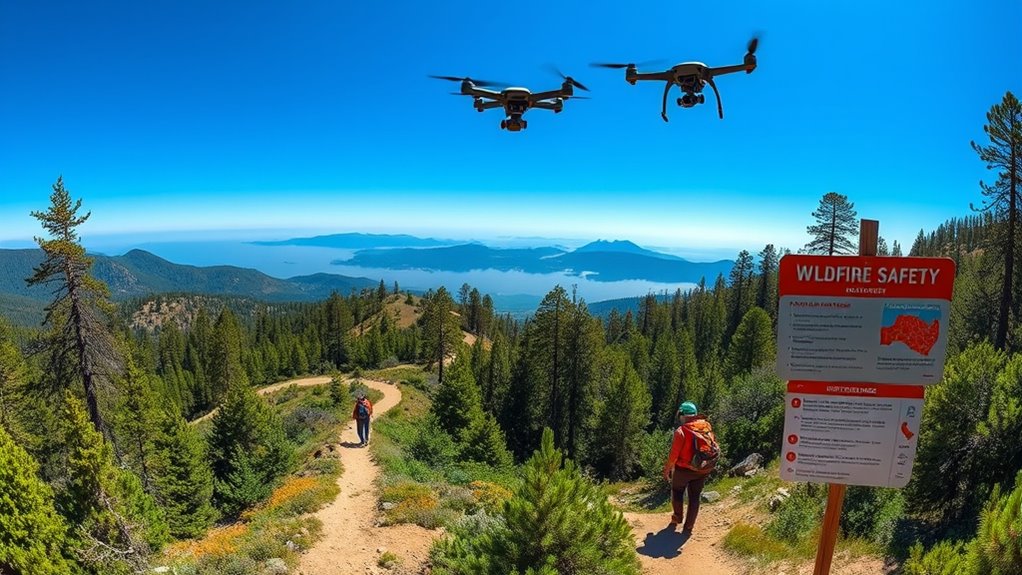
If a wildfire suddenly erupts while you’re in the Sierra Nevada, knowing how to respond quickly can save your life. You should be familiar with evacuation routes and have your safety supplies ready to grab. Being prepared guarantees you can act swiftly and stay safe until help arrives. Additionally, staying informed about local security measures can help you react more effectively during an emergency.
Emergency Evacuation Procedures
Recognizing the urgency of a wildfire situation is essential, and knowing how to respond quickly can make all the difference. If a fire erupts, stay calm and follow your pre-planned evacuation routes to reach safety efficiently. Keep an emergency shelter list handy, and avoid congested roads. When evacuation orders are issued, leave immediately—do not delay to gather belongings. Drive carefully, stay alert for changing conditions, and listen for updates via radio or cellphone. Remember these key points:
- Know your designated evacuation routes before heading out
- Have a contact plan to inform loved ones of your location
- Keep your vehicle fueled and ready at all times
- Stay aware of nearby emergency shelters for refuge
- Avoid shortcuts or unfamiliar paths that could be blocked
- Understanding Frictional unemployment can help identify new opportunities for growth during challenging times.
Quick, informed actions are critical to staying safe during wildfires.
Wildfire Safety Supplies
Being prepared with the right safety supplies can make a significant difference during a wildfire emergency. Make sure you have fire resistant clothing to protect yourself from heat and flames. Carry a portable fire extinguisher in your vehicle or backpack to quickly suppress small fires before they spread. Keep an emergency kit with essentials like water, snacks, a flashlight, and a first aid kit. If a wildfire breaks out nearby, stay calm and use your fire resistant clothing to shield yourself if needed. Use your portable fire extinguisher to control small fires or flare-ups. Always follow evacuation orders promptly, but having these supplies on hand guarantees you’re better equipped to respond safely and effectively in critical moments.
Respecting Fire Restrictions and Local Guidelines
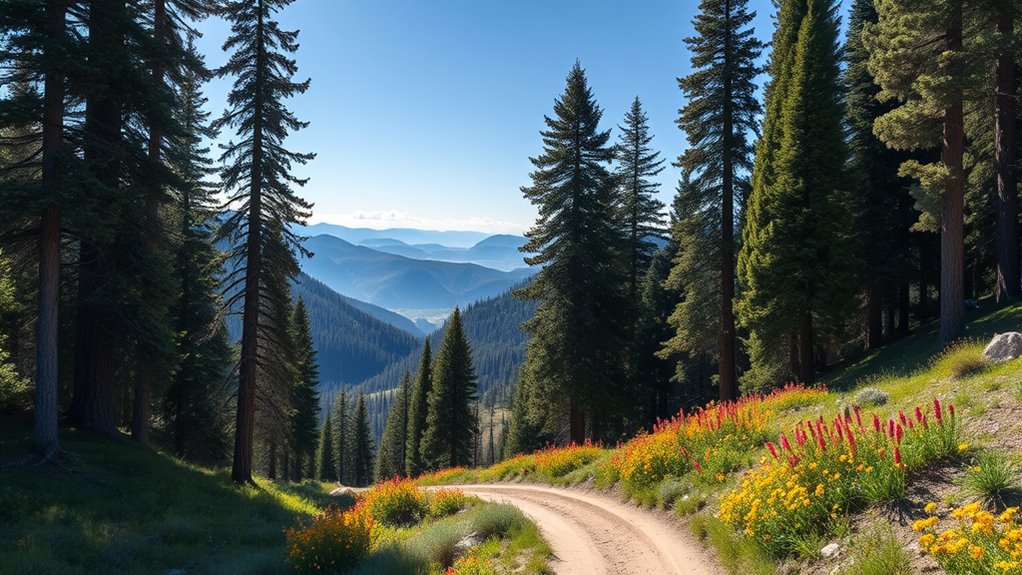
To enjoy your trip safely, it is vital to follow fire restrictions and local guidelines in the Sierra Nevada. Respecting fire ban enforcement and local jurisdiction guidelines helps prevent wildfires and keeps everyone safe. Always check current restrictions before your visit, as they can change quickly. Violating these rules can lead to fines or even criminal charges. Be mindful of campfire limits, smoking areas, and parking restrictions related to fire safety. By adhering to these guidelines, you contribute to wildfire prevention and support local efforts to protect communities and natural resources.
- Understand fire ban enforcement policies
- Follow designated campfire and smoking zones
- Respect parking and access restrictions
- Stay informed on changing fire conditions
- Support local efforts by staying compliant
Frequently Asked Questions
Are There Specific Times of Day When Wildfires Are Most Likely?
You should be aware that fire risk mornings are generally lower, as cooler temperatures and higher humidity help prevent wildfires. However, wildfire activity tends to increase in the evenings when it’s warmer, drier, and winds pick up. To stay safe, plan outdoor activities earlier in the day and avoid strenuous activities during peak wildfire times in the evenings when the risk is higher.
How Can I Support Wildfire Prevention Efforts While Traveling?
Think of wildfire prevention as a shared garden; your care helps it thrive. While traveling, you can support efforts by practicing fire prevention—never leaving campfires unattended and properly disposing of cigarette butts. Engage with local communities by volunteering or spreading awareness. Your small acts are like sparks that can stop a blaze before it starts, helping protect the beautiful landscapes you love and ensuring everyone enjoys safe adventures.
What Insurance Coverage Should I Consider for Wildfire-Related Emergencies?
When considering wildfire-related emergencies, you should evaluate your Travel insurance coverage to make certain it includes wildfire insurance. Check if your policy covers evacuation, trip cancellations, or delays caused by wildfires. It’s wise to read the fine print and discuss with your insurer to confirm all wildfire risks are covered. Being prepared with the right travel insurance coverage gives you peace of mind, knowing you’re protected if wildfires impact your plans.
Can Wildlife Be Dangerous During Wildfire Season?
Wildlife can be dangerous during wildfire season because their behavior changes, often making animals more aggressive or defensive. You should always stay cautious and remember wildlife safety tips, like keeping a safe distance and not feeding animals. Stay alert to signs of wildlife activity, and if you encounter animals, move away calmly. Understanding their behavior helps protect both you and the wildlife during this stressful time.
Are There Any Apps for Real-Time Wildfire Risk Assessments?
You can stay informed with fire risk apps that offer real-time wildfire alerts, helping you assess danger levels easily. These apps provide up-to-date information on fire conditions, evacuation zones, and safety tips, so you can plan your travels accordingly. By checking fire risk apps regularly, you’ll be better prepared and can make smarter decisions to avoid wildfire hazards during your trip, ensuring a safer and more enjoyable experience.
Conclusion
By staying alert and respecting fire restrictions, you’ll navigate California’s Sierra Nevada like a seasoned traveler steering through a storm. Keep monitoring updates, plan your route carefully, and pack smartly to guarantee a safe adventure. Remember, wildfire risks are like shadows—always present but manageable with awareness. When you stay informed and prepared, you’ll turn potential hazards into mere ripples on your journey, allowing you to enjoy the breathtaking landscape without fear.

